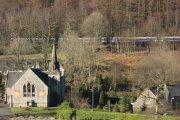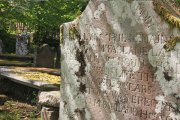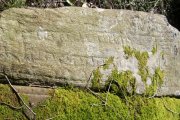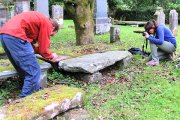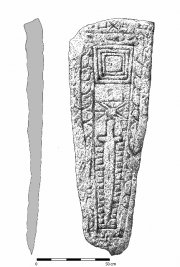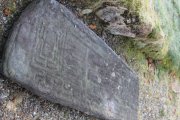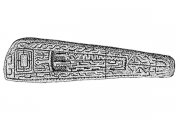Graveslab Interpretation
Ballyhennan Burial Ground
There is an old burial ground at Ballyhennan half-way across the isthmus. It is indicated on General Roy's Military survey of 1750, which refers to it as 'Killchenn'. The adjacent Ballyhennan Church was built as a Free Church in 1844. There are several old tombstones, some with Gaelic inscriptions, in the graveyard. Click here to see a plan of the graveyard, and to access photos of the stones and records of their inscriptions.
Photography
Most of the gravestones in the graveyard date from the mid-1700s and later, though one slab appears to be much older. The slab is unremarkable in the daylight, with hardly any markings apparent. However, the Hidden Heritage Project visited the slab in the dark, and used torches to create shadows. Local resident, Iain Dick took some amazing pictures, stitching them together to create a beautiful image (see photos). Iain's photos made us realise this slab was special. Was it a sword we could see? Was there a gaming board or maze at one end? And possibly the clan MacFarlane heraldry?
We invited experts from the Royal Commission on the Ancient and Historical Monuments of Scotland (RCAHMS) to come and look at the stone and photograph it using their high-tec equipment. This also produced some amazing photos that show much more than can be seen with the naked eye, as well as ensuring that a visual record of the stone will be kept in the RCAHMS archives.
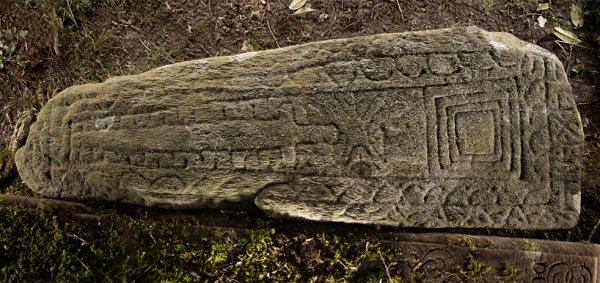
16th Century Stonemason?
We needed to know more! We invited Dr David Caldwell (archaeologist and retired Keeper of Scotland and Europe at the National Museums Scotland) to view the slab. His first reaction was that, in part due to the geometric patterns, it was likely created in the 18th or 19th centuries. However, after discovering an illustration of a slab with almost-identical markings in Kilmorich Church graveyard, Cairndhu, he revised his opinion. The Kilmorich slab was dated to the 16th century by RCAHMS, and David deduced the stonemason was almost certainly the same person who created the Ballyhennan slab. It is therefore quite likely that our graveslab also dates to the 1500s.
Photogrammetry
We felt it was vital to analyse the stone in more detail. We commissioned Alice Watterson and Kieran Baxter to record the stone using a technique called photogrammetry, which could reveal minute indentations in the stone. They created a beautiful and unique animation of the slab, illuminated from different angles. Please click here to experience this innovative interpretation. Alice also produced a more traditional, drawn illustration. For more information about Alice and Kieran's work, please visit www.digitaldirtvirtualpasts.wordpress.com/ and www.topofly.com/ and visit Alice's blog, which explains the processes used to obtain these results - a real insight into the work of archaeologists!
There is still one enigmatic space on the slab that has no evident sculpturing. Can you see where it is? Do you have any ideas about what could have been there at one time?
Blog
Click on the link here to check out our Facebook page.
Events
Click here to find out about forthcoming events and how to get involved.
Timeline
Click here to see our timeline of events.
Location
Click here to find out where the Hidden Heritage Project is taking place.
Contact Us
Click here for our contact details.


